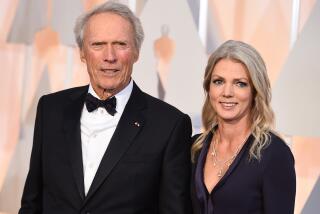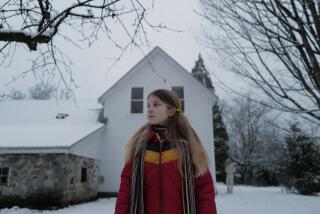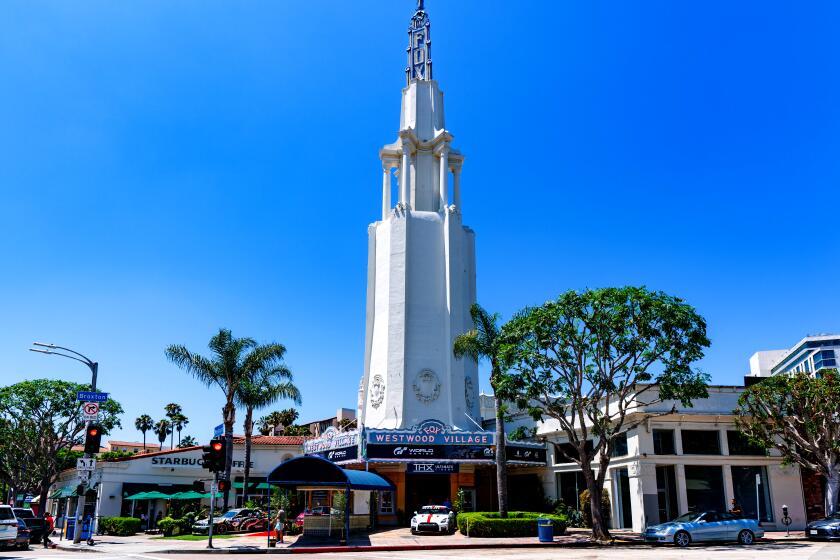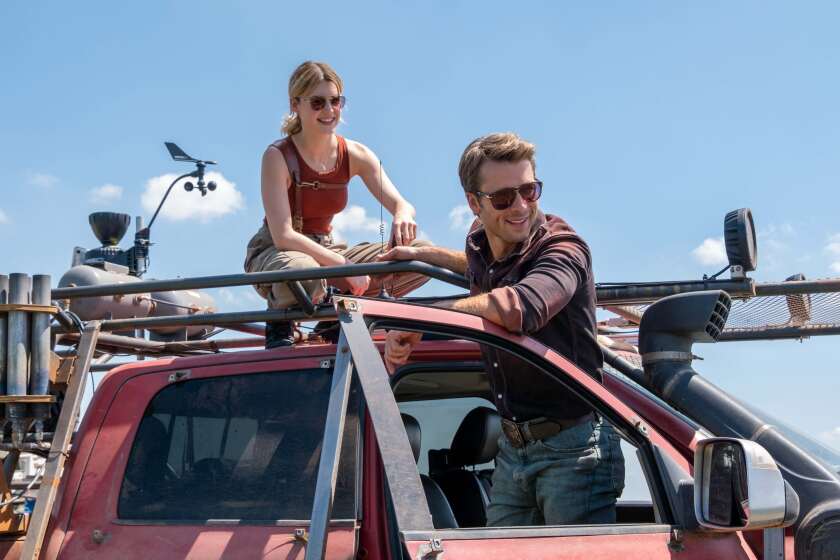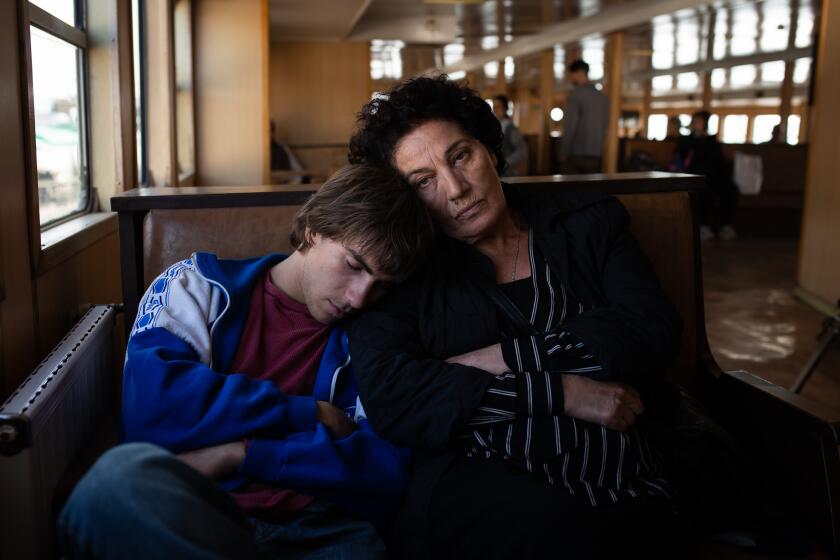Coming of Age as Neighbors in L.A.
Leslie Campos is having the summer of her life at the age of 17.
With a minor role in a hot new movie she helped inspire and a tight friendship with the directors, she now has lots to talk about with her pals besides boyfriends, shopping and what they want to be when they grow up.
Hers is just a bit part without lines, sure, but she also sings in the movie, and who knows what would happen if she kept at it? She’s got talent, and she’s definitely got connections.
“Did your mother like the movie?” I ask in Leslie’s Echo Park living room.
“Yes, she liked it,” Leslie says with her nervous giggle. “No, she loved it.”
Mom walks into the room with a big smile and confirms the rumor.
Yes, Mrs. Campos says. She loved it.
The movie is “Quinceanera,” the Spanish name for the 15th birthday ceremony that celebrates a girl’s passage into womanhood. One reason the Campos family raves about the movie, which won two prizes at Sundance this year, is that they helped inspire it.
The tale of how the movie got made is almost as good as the movie, and it’s an only-in-L.A. story.
It started when a gay couple, Richard Glatzer and Wash Westmoreland, moved from a place near La Brea and Melrose to Echo Park, settling in next door to the Camposes.
On paper, this was not a match made in heaven. Glatzer and Westmoreland, who were fixing up a Craftsman, represented the gentrifying army that is driving up prices and forcing out longtime residents in Echo Park and elsewhere in Los Angeles, many of them lower-income Latinos. Worse, one of the men had directed a few porn movies. The Campos family, meanwhile, has images of the Virgin Mary in their home, and Mr. Campos is the preacher at a Pentecostal church on Sunset Boulevard.
But the newcomers loved their hilly new neighborhood on the border of Silver Lake, south of Sunset. And their neighbors, led by Leslie and the Campos family, loved them back.
“My father doesn’t judge people,” says Leslie, who leads the youth choir at her dad’s church, which also found its way into the movie.
As a young teen, Leslie fed Glatzer and Westmoreland’s dogs, Polo and Arthur, and watched them while the owners were away. When Glatzer worked on “America’s Top Model,” he brought Tyra Banks home for Leslie to meet. And all of them were in and out of each other’s houses for dinner and hanging out.
“A lot of people said, ‘Oh, they’ll be kissing in front of everybody,’ ” says Mario Galvez, 19, another neighbor who says he thinks Glatzer and Westmoreland were the first gays in the neighborhood.
But once people got to know the newcomers, their sexual orientation wasn’t an issue. They threw good parties and invited the neighbors, says Galvez, who also ended up with a bit part in the movie, although he has had trouble convincing his boss at Macy’s in the Beverly Center that he’s on the big screen in theaters around the country.
“He wouldn’t believe me,” Galvez says. “I told him, ‘Go see it.’ ”
When it came time for Leslie’s quinceanera two years ago, Glatzer and Westmoreland were blown away by the preparation, the waltz practice, the formal outfits worn by members of the court and the ceremony itself. They were invited to the party by Leslie, who asked them to photograph it.
Six months later, Glatzer and Westmoreland decided to build a movie around a quinceanera. It took just three weeks to write and four months to complete. And it cost only $400,000, a fraction of the typical movie budget.
The movie is a loving and un-cliched coming-of-age narrative, a valentine to Echo Park and a sharp commentary on the displacement caused by gentrifiers like you-know-who. In the movie, the longtime neighbors of an opportunistic gay couple -- a couple with much less heart than Glatzer and Westmoreland -- are forced out when the rents go up, and that plotline came from real life.
A Latino family purchased the three-unit property next door to Glatzer and Westmoreland about the time the movie was completed, forcing out Leslie’s family, Mario’s family and one other.
“We were working on the movie, and Leslie was so upset about leaving,” says Glatzer.
The Campos and Galvez clans were able to pool their money and buy a duplex together about a mile away, and that’s where they now live. But Leslie and Mario still miss their old street, and they couldn’t wait to pile into my car and go and show me their old digs.
“We’re still getting used to it,” Leslie said of being away from the place she considers home, and the place where her parents paid rent for 29 years.
They weren’t the only ones who got the boot. On the other side of the Glatzer-Westmoreland house, a home that was standing since 1915 got bulldozed when the land was sold. The directors went to City Hall to fight it, but now the concrete foundation is in place for a four-unit condo complex, and the former residents, a Latino family, have relocated to South-Central.
When I met with the directors, we talked about their complicated feelings regarding their move to Echo Park. They’re part of a force that is changing what attracted them to the neighborhood in the first place, and yet they’ve been enriched by their neighbors, and vice versa.
“When we looked at one scene we were shooting, I said to Richard, ‘Do you believe this is our movie? We’ve just shot an entire scene in Spanish, and we don’t speak Spanish,’ ” Westmoreland said.
I told them they shouldn’t feel guilty about moving to Echo Park any more than I should feel guilty about moving to Silver Lake. In both cases, we wanted some edge and diversity and, more important, something that didn’t cost a million dollars.
But that doesn’t mean there aren’t ways to build and preserve neighborhoods that are mixed racially and economically, even though California and Los Angeles have done such a lousy job of it.
Peter Dreier of the Urban and Environmental Policy Program at Occidental College told me a good four-point plan would include a moratorium on condo conversions, stronger rent control laws, passage of affordable-housing bonds and approval of inclusionary zoning, which requires developers to build mixed-price units in residential developments.
If “Quinceanera” fills their pockets, maybe Glatzer and Westmoreland can bankroll politicians who are willing -- unlike most of the current crop -- to lead the charge. Or they can buy the condos next door and rent them to their old neighbors.
A great Hollywood ending. And Leslie Campos, who is having the summer of her life before starting her senior year in high school, would jump at the chance.
Reach the columnist at www.latimes.com/lopez and read previous columns at www.latimes.com/lopez
More to Read
Only good movies
Get the Indie Focus newsletter, Mark Olsen's weekly guide to the world of cinema.
You may occasionally receive promotional content from the Los Angeles Times.
